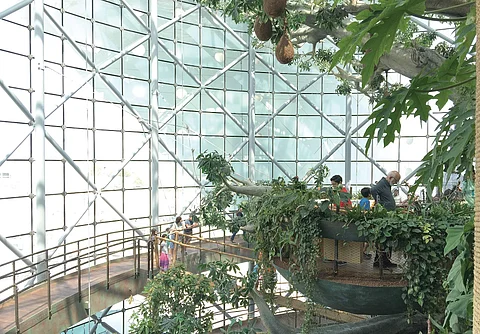

From a desert, I’m suddenly transported into the heart of a lush, tropical rainforest with its attendant sights, sounds and smells. No, it wasn’t a time machine that did it, but Dubai’s latest attraction, The Green Planet, an enchanting bio dome where over 3,000 plants, birds and animals co-exist in the world’s oldest ecosystem.
As I enter the five-level origami-styled glass building in the spiffy City Walk area of Jumeirah, I’m greeted by the Flooded Forest, the base level of the tropical ecosystem. A giant aquarium filled with fish species such as arapaima, arowana and graceful stingrays has me reaching out for my camera. The aquarium replicates different types of fish and animals found in underwater tropical environments.
Towering above me is a 25-metre Kapok tree, which serves as the anchor at The Green Planet. Native to Central America, this is the world’s largest fabricated self-sustaining tree. Although its knobby trunk is artificial, each branch has planters packed with tropical flora and fauna, including rare plants such as the bromeliad. “Eventually the plants growing on the tree will take over the structure to create a living breathing environment in which tropical species can thrive,” a staffer informs me.

I whiz up in an elevator to the bio dome’s roof, which offers a panoramic sweep of the entire ecosystem, complete with the waterfalls, steam and sounds associated with an Amazon rainforest. Exotic wildlife, such as South American toucans and crocodile lizards, tree boas, spiders, colonies of worker ants and brightly coloured parrots and tree frogs add to my viewing pleasure. Each exhibit has been carefully selected to thrive in the artificial environment. For instance, the fish came from breeders in Singapore, and the plants were imported from Thailand and India.
“The delicate layers of the forest have been recreated with different plants and animals that help transport visitors to the real Amazonian ecosystem,” the staffer adds. “Meticulous planning has gone in to ensure that each exhibit is sourced from responsible breeders from around the world. It is vital that the species are capable of coexisting in a hybrid environment.”
Environmental parameters in the bio dome have been designed to maintain the plants and wildlife. Temperatures are regulated between 25°C and 28°C, and mists are sprayed to recreate the sensory experience of a tropical rainforest. According to Eric Hupperts, a Californian wildlife expert and manager and curator at Green Planet, the bio dome is a living, breathing classroom that offers an engaging experiential about tropical wildlife.
I tiptoe over a hanging bridge connecting one end of the gigantic Kapok tree to the other, which houses birds such as Purple Glossy Starling, Crimson Rumped Toucan, Black-naped Oriole, Golden Conure (the national bird of Brazil) and toucan. Exotic hyacinth macaws, geckos, crocodile lizards, porcupines and a sloth jostle for my attention.
After viewing the top deck, I descend down a winding path saying hello to exotic and tropical animals along its periphery. “There’s the resident sloth there,” my escort points to a furry creature moving surreptitiously behind thick foliage. The animal has free rein to roam but doesn’t do so too quickly living up to its name quite literally.
As I get back to the ground level, I’m escorted to the terrariums (sealed glass containers), which hold live insects such as the Goliath Birdeater Tarantula (the world’s largest spider native to South America) and weaver ants from Southeast Asian forests.
From a bowl of insects I gingerly try to feed a toucan. As I reach out to the bird holding the creepy crawlies in my palm, it promptly dips its beak and gobbles up the proffered delicacy. As I step out of The Green Planet, still enveloped in its sounds and smells, I feel enriched having discovered the beauty of a fascinating ecosystem and the treasure trove it holds.